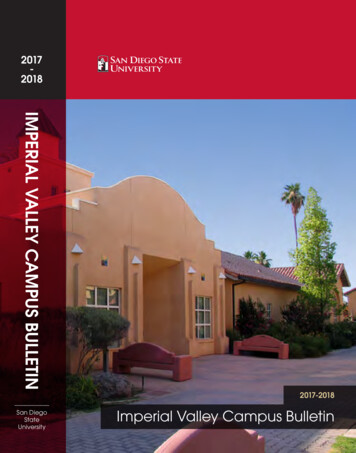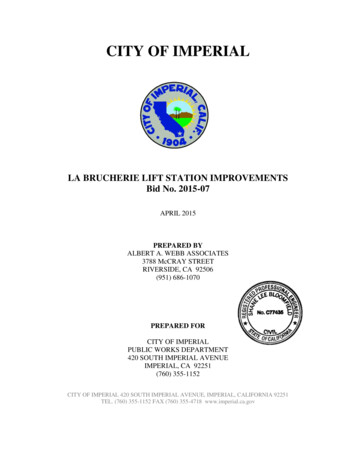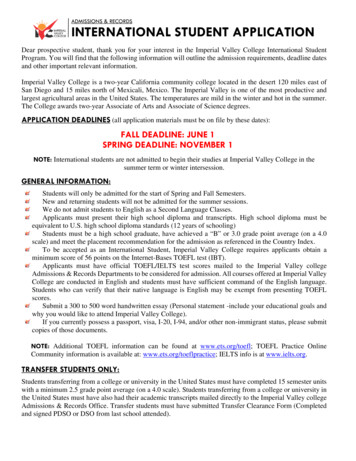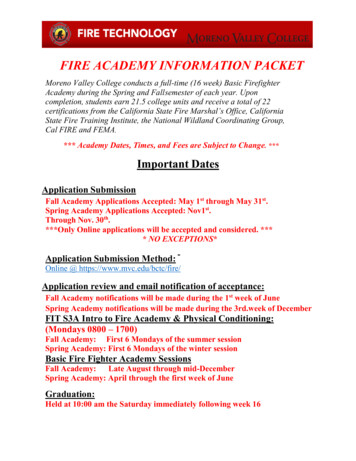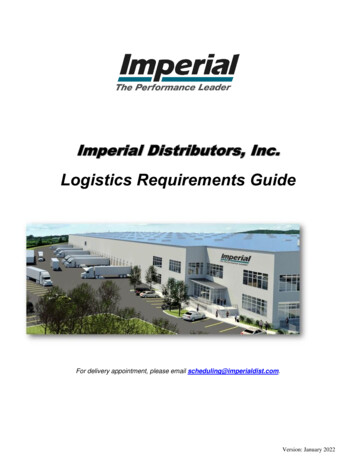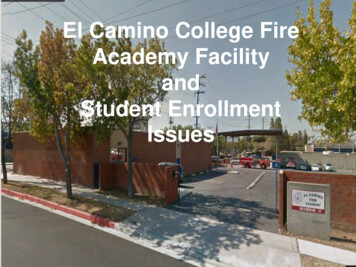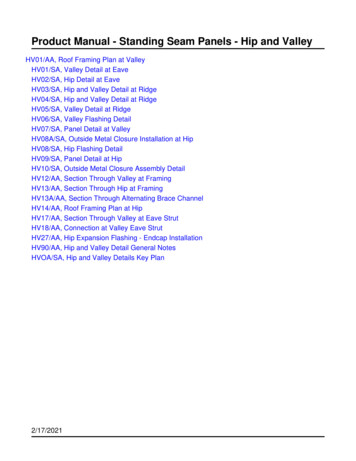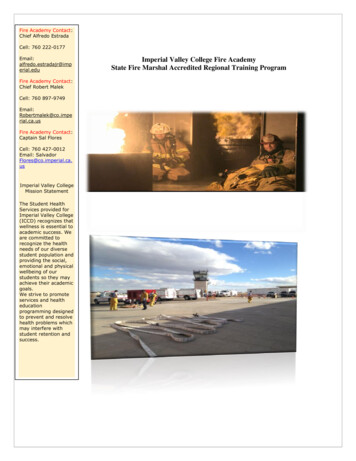
Transcription
Fire Academy Contact:Chief Alfredo EstradaCell: 760 222-0177Email:alfredo.estradajr@imperial.eduFire Academy Contact:Chief Robert MalekCell: 760 897-9749Email:Robertmalek@co.imperial.ca.usFire Academy Contact:Captain Sal FloresCell: 760 427-0012Email: SalvadorFlores@co.imperial.ca.usImperial Valley CollegeMission StatementThe Student HealthServices provided forImperial Valley College(ICCD) recognizes thatwellness is essential toacademic success. Weare committed torecognize the healthneeds of our diversestudent population andproviding the social,emotional and physicalwellbeing of ourstudents so they mayachieve their academicgoals.We strive to promoteservices and healtheducationprogramming designedto prevent and resolvehealth problems whichmay interfere withstudent retention andsuccess.Imperial Valley College Fire AcademyState Fire Marshal Accredited Regional Training Program
Table of Contents:Page 1Page 2Page 3Page 4Page 5Page 6Page 7-8Page 9Page 10-11Page 12Page 13-17Page 18-19Page 20-27Page 25Page -88Course Name and Location InformationCourse Syllabus, Goals, and ObjectivesClass Materials and Uniforms, Grading Systems and Examination StandardsAcademic Behavior Procedures and RulesCadet Code of ConductPlagiarism and CheatingUniforms and GroomingLine up AbsencesAddressing Staff, Instructors, and Visitors, General PerformanceWeekly Evaluations and Academic ProbationStudent Learning OutcomesOnline Student Log in DirectionsTermination from the Academy,Disability/Sexual Harassment PolicyHow to file a complaint/ Contact InformationNo eating and drinking/ Important DatesImperial Valley College Fire Cadet Guidelines, Rules and Regulation SOP 100 ManualImperial Valley College Fire Academy Instructor Guidelines, Rules and Regulation SOP 200ManualCourse SyllabusBasic Fire Academy I is the first of two courses of the Fire Academy designed for the individualwho desires a career as a professional fire fighter. This course includes instruction in basicfirefighting skills, personnel rules and regulations in professional organizations, equipmentoperation and maintenance, elementary fire behavior, fire ground safety and operations, selfcontained breathing apparatus operation and maintenance, portable fire extinguisher operationand maintenance, firefighting tactics and strategies on the fire ground. This course is intensive,requiring the students’ total dedication for successful completion.Course GoalsThe goal of the Basic Fire Academy I is to prepare the firefighter candidate to become a State ofCalifornia Certified Firefighter I. Completion of these skills is required by most Fire ProtectionAgencies as the minimum requirements of those persons applying for full and part timeemployment. Pre-employment training is the main theme of this education and trainingexperience.
Course ObjectivesThe objectives of this academy are for an individual to meet the requirements of theNational Fire Protection Association (NFPA) Standard 1001, Standard for Fire FighterProfessional Qualifications and California State Fire Training, Fire Fighter I certificationprogram.Class Materials and UniformsThe following text and materials are required for this course:Textbooks: Advantage Package Fundamentals off FF 3rd Edition Combined withVehicle Extrication and Navigation Course Manager3-Ring notebook with paper/Pen/PencilsAcademy Class B Uniform: Phoenix Uniforms (935 North Imperial Ave El CentroCa)Academy Fitness Uniform: American Embroidery (119 N. 5th, El Centro Ca)
Grading System and Examination StandardsTo receive a certificate of completion from the Fire academy, a cadet must satisfactorily meetTo pass the Imperial Valley College Basic Fire Academy a cadet must achieve anaccumulative score of 70% or better, successfully pass a written final and manipulativeskill examination. A major safety violation during the skills portion is grounds fortermination from the program.Letter Grades: A- Superior 90%-100%, B-Better than average 80%-90%, C-Average 70%80% D- Below Average, F-Below 70% FailingAcademy Behavior Procedures and RulesThis section sets forth guidelines for the administration of policies, procedures, and operationsthat regulate the conduct and responsibilities of all members assigned to the Imperial ValleyCollege Basic Fire Academy ( FT-130).All cadets involved in the Imperial Valley College Basic Fire Academy shall adhere to theguidelines, contained in this section and to all the Imperial Valley College policies andregulations. The Academy recognizes that due to the nature of training, modifications to theguidelines may be necessary in order to maintain program continuity however; such changesshall be kept to a minimum.The Imperial Valley College Basic Fire Academy is an arduous, highly disciplined, anddemanding program. A high level of commitment, training, and discipline is necessary toeffectively prepare cadet firefighters for the responsibilities and dangers inherent to the fireservice. The training is presented in both the controlled environment and in dynamic settingsdesigned to simulate the field environment in the fire service.The Imperial Valley College Basic Fire Academy Instructors will instruct, train, evaluate, and
discipline in a fair and equitable manner emphasizing the cadets basic skills, abilities, physicalconditioning, and attitude. The Instructors will observe, evaluate, and instruct all aspects of thecadets performance. The basic objective of the Imperial Valley College Basic Fire Academy is toprepare cadets to become a safe and effective entry-level firefighter.Cadet Code of ConductAll Cadets in the Imperial Valley College Basic Fire Academy shall:Support the Constitution of the United States of America and the State of California; obeythe policies, procedures, and code of conduct of the Imperial Valley College.Participate and live by ethical conduct in actions, words, and deeds. Be honest, fair, andtolerant of other’s differences.Practice integrity: If a decision is made that is later determined to be incorrect, admit to theerror regardless of the consequences. Take responsibility and stand accountable for youractionsBe ethical: Do what you know to be right even in the face of resistance or peer pressure.Commit to excellence: Give 100% in everything you do. Do not judge yourself bycomparison to others, but by your own sense of self-esteem and personalaccomplishment.Be decisive: Make decisions based on what you have been taughtBe honest: Never lie, cheat, or tolerate another cadet who does.Be responsive to constructive criticism.Respect the Imperial Valley College Basic Fire Academy Instructors and your peers.Cadets shall assume an obligation to conduct themselves in a manner compatible with the
college’s function as an educational institution. Cadets shall observe the rules andregulations of the College (Fire Academy).Plagiarism and CheatingCheating is defined as fraud, deceit, or dishonesty in an academic assignment or using orattempting to use materials, or assisting others in using materials, or assisting others in usingmaterials which are prohibited or inappropriate in the context of the academic assignment inquestion, such as:copying or attempting to copy from others during an examination or on anassignment;communicating test information with another person during an examination;allowing others to do an assignment or portion of an assignment, including the use ofa commercial term paper service.Plagiarism includes the deliberate misrepresentation of someone else's works and ideas, as one'sown, as well as paraphrasing without footnoting the source.The bottom line is you cannot copy anything directly from any source including your textbooksor the Internet, unless you are using a quotation and you must note the book or article or website,and page number from the source of your quote. If you paraphrase something, you must also citethe source of your information. If you copy and paste other people's writing into youranswers on any assignment, the assignment will be given "0" points the first time you do itand if you do it again, you will be terminated from the academy. If you use plagiarizedmaterial in your firefighter assignments (even if it is just a single sentence), you will receivea "zero" for the assignment and an "F" for the course.
As a cadet, you are entitled to be treated with respect and dignity regardless of race, gender,religion, age, sexual orientation or national origin. You have the right to learn in an environmentfree from discrimination, harassment, and retaliation. You must not engage in any discriminatorybehavior. Your conduct at all times reflects not only yourself, but also of this academy andeducational institution.Uniforms and GroomingUniforms and grooming standards shall be maintained and kept in an acceptable condition. Eachcadet has a responsibility to personally contribute to the overall image of the Imperial ValleyCollege Basic Fire Academy.Hair standards: A neat, clean, and well-groomed appearance contributes to building prideessential to an effective Basic Fire Academy. A vital ingredient of the Basic FireAcademy’s effectiveness is the pride in self-discipline, which each cadet brings to ourprogram. It is the responsibility of each member to be properly groomed while in theprogram.There are many hair styles which are acceptable to the Imperial Valley College Basic FireAcademy. As long as the style does not lessen the protection of required safetyequipment or expose the member to added personal injury. The acceptability of the stylewill be judged by the Lead Instructor using the following criteria: The length and/or bulkof the hair shall not be excessive or present a ragged or extreme experience. Hair styling(outward flip, teased, Afro, perm, block, or tapered), shall not cause hair to exceed inlength or bulk the standards described in this sectionLength of hair on back of the head shall not extend over the top of the collar of the dressuniform when standing with the head erect. Hair my cover part of the ear, but the lowerone-inch of the ear (when measured from the bottom of the ear) must remain exposed.Hair bulk shall not exceed one and one-half inches in depth, tapering at the sides, andback to a maximum depth of one inch at the top of the collar when in dress uniform, and
a maximum of one-fourth of an inch beyond the outer edge of the ear. At no time shallthe hairstyle interfere with the proper sealing of a face-piece or the proper fit andappearance of approved headgear.Female Cadets: Female cadets shall wear their hair in a style that does not lessen theprotection of required safety equipment or expose the cadet to added personal injury. Ifhair is long, it shall be pulled back and secured off the face and neck. Single ponytail orbraid, including French braids may be worn providing the bottom end of the braid doesnot extend any longer than six inches from the top of the collar.Sideburns: Sideburns shall be well groomed, neatly trimmed, and shall not extend beyondthe inner seal of a properly worn breathing apparatus face-piece. Sideburns shall notextend below horizontal line level with the bottom point of the ear when the head is erect.Moustaches: Moustaches shall not cover the upper lip, shall be well groomed, neatlytrimmed, and shall not protrude the natural facial “smile” crease, nor extend beyond ½”below the corner of the mouth. Extreme styling of moustaches is not permitted.Beards and goatees: of any type are prohibited.All cadets shall be clean-shaven by 08:00 hours and at any other time when reporting to theAcademy.Cosmetics: Female members are permitted to wear cosmetics. All cosmetics are to be wornin conservative amounts and color.Fingernails: Fingernails are to be kept neat and clean; for safety reasons, shall be no longerthan 1/8” beyond the tip of the finger. If nail polish is worn, it shall be pale in color. Nobright colors will be allowed.
Jewelry: Jewelry or personal ornaments shall not be affixed to any part of the uniformequipment. Members shall not wear any unauthorized ornamentation such as earrings,flag pins or necklaces. Religious and Medic Alert medals may be worn, provided they donot show outside of the uniformSunglasses/wrist watches: Sunglasses and wrist watches may be worn during the FirefighterFitness portion of the Academy. The sunglasses must be of a color that blends in with theAcademy’s uniform ( example: black, brown, silver, blue, gold, etc. ) Fluorescent orbright colors shall not be worn while on duty. Sunglasses shall not be of a type thatrestricts member’s peripheral vision.Uniforms: The cadet will have two uniforms. His or her academy uniform and theirFirefighter Fitness uniform. The academy uniform and Firefighter Fitness uniformspecifications are included in this packet.Line-UPAll cadets shall line-up at the designated location at 18:30 p.m. on Wednesday’s and 08:00a.m. on Saturdays . Cadets shall be properly attired and present with all necessarypersonal protective equipment.AbsencesIn case of absence due to an emergency or illness where the cadet is unable to report to theacademy, the recruit shall personally notify a member of the appropriate training staff.Messages left on someone’s telephone do not constitute notificationUnexcused absences or unexcused tardiness will result in corrective action.
Addressing Staff, Instructors, and VisitorsChief Officers are addressed by rank and last name (“Chief Adams”.) If the last name is notknown, by only (“Chief”) or “sir/ma’am” (as appropriate).Captains are addressed by rank and last name (“Captain Adams”.) If the last name is notknown, by only (“Captain”) or “sir/ma’am” (as appropriate).Peer Group are addressed by rank and last name (“Firefighter Adams”.) If the last name isnot known, by “sir/ma’am” (as appropriate).Cadets shall not enter any office before knocking first and being acknowledged. Uponacknowledgement of the cadet by a staff member, the cadet will state his/her purpose andreport to the desk/location of the staff member whom he/she wishes to speak.General PerformanceListed below is required performance and skills to be a safe and effective cadet. Failure in one ofthese areas may result in a recommendation for termination from the Imperial Valley CollegeBasic Fire Academy.Strength and StaminaThe strength and stamina of all cadets will be continuously evaluated throughout the Academy.Each cadet will take part in fitness evaluations during the program. Cadets must demonstrate thestrength and stamina to safely and effectively perform the tasks of an entry-level firefighter.
Manipulative SkillsAll cadets will be required to develop sufficient manipulative skill to properly handle the tools,equipment, fittings, and breathing apparatus to complete their Firefighter I certification and passthe skills in accordance with the 5th Edition Essentials.ProfessionalismA professional demeanor is demonstrated by the manner in which a recruit presents him/herselfin and out of the Academy. Professionalism is demonstrated in both performance and personalappearance. Personal appearance means neatness, good grooming, and being in uniform asdirected. Additionally, awareness of and observance of the chain is another element ofprofessional conduct in a paramilitary organization. All of these elements are subject toevaluation. Unprofessional behavior will not be tolerated.Work EthicA positive work ethic is a collection of values and actions that appropriate for the workplace.Work ethics are traits such as punctuality, attendance, efficient use of time, character,appearance, productivity, communication, cooperation, respect for others, initiative, andteamwork.AcrophobiaAll cadets will be required to perform a variety of above ground evolutions. Manifestations ofacrophobia (fear of heights), such as failure to perform and above ground evolution or excessivehesitation during an above ground evolution, demonstrates an inability to perform the tasksnecessary to be a safe and effective Basic Firefighter Academy cadet.
Weekly Evaluations and Academic ProbationEach week during the Academy, each cadet will receive a weekly evaluation from the LeadInstructor. This evaluation will include your academic and manipulative scores for the week. Itwill also include any observed performance that is below standard. This evaluation is for thecadet to receive feedback regarding any barriers to learning or perceived deficiency in theprogram. Failure to maintain a standard level of performance will lead to academic probation.Continual failure to maintain a standard level of performance demonstrates an inability toperform the tasks necessary to be a safe and effective Basic Fire Academy cadet. Additionaltraining, counseling, oral reprimands, deficiency notices or personal notices will be issued tocadets who fail to meet the Imperial Valley College and Imperial Valley College Basic FireAcademy standards. The Academy standards will include, but not be limited to the following:Physical PerformanceManipulative PerformanceAcademic PerformancePersonal Appearance/UniformProfessionalism and Work on of Imperial Valley College and Imperial Valley College Basic Fire AcademyThe Levels of corrective action will be as follows:Counseling AA verbal and written warning to improve the deficient behavior in Academy standards. Directionfor improvement will be given, and the cadet will be put on Academic probation for two weeks.Counseling BA verbal and written warning to improve the deficient behavior in Academy standards. Directionfor improvement will be given, and the cadet will be put on Academic probation for two weeks.
Counseling CA verbal and written warning to improve the deficient behavior in Academy standards. Directionfor improvement will be given, and the cadet will be put on Academic probation for two weeks.Counseling DA verbal and written warning to improve the deficient behavior in Academy standards. Directionfor improvement will be given. The cadet will have meeting with Academy Coordinator, Dean,and Disciplinary Committee.Termination Counseling E/ Termination from the Imperial Valley College Basic Fire AcademyStudent Learning OutcomesUpon successful completion of this course, the student will be able to:Students will define fire department organization and culture, and the expectations of entry-level fire department personnel.Student will demonstrate knowledge of fire department equipment through the selection and application of equipment for givenfirefighting tasks.Student will analyze and assess firefighter hazards inherent to the profession.Student will demonstrate the ability to communicate effectively through multiple methods of communication including: written,electronic, face to face, and radio transmitted messages.Student will demonstrate their knowledge of strategies, tactics and incident command through the selection and implementationof firefighting methods, and the application of the Emergency Command System.Student will demonstrate safe practices by using minimum standard safety procedures.Types of Assessment to be used:
SLO #1Assessment Instrument(s)Assessment ExampleSLO Attainment Criteria-Students will define anddemonstrate knowledge offire department organizationand culture, and theexpectations of entry-levelfire department personnel.Written quizzes that address firedepartment culture and employeeexpectations. Physical trainingperformance measured againststandard physical testing criteria.Final exam to measure the student'scomprehensive knowledge of all FireAcademy subjects.Select one instrument to“assess” the studentlearning outcome. Forexample: physical ability.Students will be issued aphysical abilitiesassignment to complete aphysical abilities test.Success is achieved if 90% ofstudents achieve the studentlearning outcome with a scoreof 70% or higher during theassigned assessment activity.Learning outcome is notachieved if these criteria arenot met.SLO #2Assessment Instrument(s)Assessment ExampleSLO Attainment Criteria-Student will demonstrateknowledge of fire departmentequipment through theselection and application ofequipment for givenfirefighting tasksManipulative skills tests to measurethe student's ability to select and donbreathing apparatus, ladders, hoseand appliances. Field exercises tomeasure the student's ability to selectand apply appropriate tools forrescue and firefighting operations,salvage and overhaul, and hazardousmaterials response anddecontamination. Written quizzes toassess the student's knowledge andapplication of equipment. Finalexam to measure the student'scomprehensive knowledge of all FireAcademy Subjects.Select a manipulative skillthat you wish to assesssuch as ladders. After thestudents complete themanipulative examassociated with ladders,assess the results todetermine if the studentlearning outcome was met.Success is achieved if 90% ofstudents achieve the studentlearning outcome with a scoreof 100% for manipulativeskills tests and 70% forwritten work. Learningoutcome is not achieved ifthese criteria or not met.SLO#3Assessment Instrument(s)Assessment ExampleDid not meet SLO-Student will analyze andassess firefighter hazardsinherent to the profession.Written quizzes to measure thestudent's ability to identify lifethreatening situations that involvebuilding construction,environmental hazards, criminalactivity, personal injury and injuriesto others. Written quizzes for thepurpose of assessing the student'sknowledge of the Ten Standard FFOrders and the 18 Situations that"Shout Watch Out" and commonfactors in line of duty deaths. Finalexam to measure the student'scomprehensive knowledge of all FireAcademy subjectsSelect a quiz orquizzes during theinstructional period thatmeasure the students’knowledge of firefighterhazards. Assess theresults to determine if thestudent learning outcomewas met or not.Success is achieved if90% of students achieve thestudent learning outcome witha score of 80% or higherduring the assignedassessment activity. Learningoutcome is not achieved ifthese criteria are not met.SLO #4Assessment Instrument(s)Assessment ExampleDid not meet SLO-
Student will demonstrate theability to communicateeffectively through multiplemethods of communicationincluding: written, electronic,face to face, and radiotransmitted messages.Self-study written work onfirefighting terms, language,acronyms, and operating procedures.Completing fire preventioninspection forms during mockinspections. Written and oralquizzes to assess the student's abilityto write, verbalize, and presentinformation on firefighting subjects.Field exercises for the purposes ofsimulating firefighter conditions andcommunications via memos,electronic media and radios. Finalexam to measure the student'scomprehensive knowledge of all FireAcademy Subjects.Select a written quiz andfield exercise to assessduring the instructionalperiod for the purposes ofassessing the students’ability to communicate.For field exercises, anevaluation instrument willneed to be developed totrack student performance.Success is achieved if 90% ofstudents achieve the studentlearning outcome with a scoreof 70% or higher during theassigned assessment activity.Learning outcome is notachieved if these criteria arenot met.SLO #5Assessment Instrument(s)Assessment ExampleDid not meet SLO-Student will demonstratetheir knowledge of strategies,tactics and incident commandthrough the selection andimplementation offirefighting methods, and theapplication of the IncidentCommand and EmergencyManagement Systems.Self-study workbook to measure thestudents’ ability to read, comprehendand apply knowledge of the IncidentCommand and EmergencyManagement Systems. Writtenexercises to assess the students’comprehension of firefightingstandard operating procedures,tactics, strategies and regulatorystandards. Field exercises tomeasure the student's knowledge offighting methods. Written quizzes toassess the student's knowledge offirefighting terminology. Final examto measure the student'scomprehensive knowledge of all FireAcademy Subjects.Analyze the student’s selfstudy work and select aquiz to analyze if thestudent learning outcomeis being met. Criteria mayinclude spelling, grammar,content, organization andlegibility.Success is achieved if 90% ofstudents achieve the studentlearning outcome with a scoreof 70% or higher during theassigned assessment activity.Learning outcome is notachieved if these criteria arenot met.Assessment ExampleDid not meet SLO-Select a manipulative skillthat represents multiplefirefighter hazards.Measure the students’performance to safely andcompetently achieve theskill. This can beachieved throughout theacademy’s manipulativeskills exams and alsoduring a final skillsperformance exam.Success is achieved if 90% ofstudents achievethe student learning outcomewith a score of 100% formanipulative skills tests and80% for written work.Learning outcome is notachieved if these criteria ornot met.SLO # 6Student willdemonstrate safepractices by usingminimum standardsafety procedures.Assessment Instrument(s)Student will be evaluated duringmanipulative exams against standardsafety practices and operatingprocedures to measure the student'scomprehension and utilization of safework practices. Example: properlifting techniques. Written quizzes toassess the student's knowledge ofstandard operating proceduresassociated with ventilation, forcibleentry, rapid intervention, rescue andfire suppression-related subjects.Final exam to measure the student'scomprehensive knowledge of all FireAcademy subjects.
SKILLUpon completion of this course, the student will be able to: Demonstrate mastery of firefightingskills based on academy instruction, including appropriate use of safe technique.PHYSICAL ABILITYUpon completion of this course, the student will be able to: Demonstrate and be physically ableto operate a variety of machines, tools and equipment which includes a motor vehicle, computer,generator, fire pump, fire hydrant, axe, shovel, hydraulic tools, power tools, hand tools, medicalequipment, etc. Must be able to use body members to work, move or carry objects or materials.Must be able to exert in excess of one hundred pounds of force occasionally, and/or in excess offifty pounds of force frequently. Physical demand requirements are at levels of those for veryheavy work.INTERPERSONAL COMMUNICATIONUpon completion of this course, the student will be able to: Demonstrate the ability of speakingand/or signaling people to convey or exchange simulated administrative, firefighting andemergency medical information during the academy. Includes giving assignments and/ordirections to fellow peers.LANGUAGE ABILITYUpon completion of this course, the student will be able to: Demonstrate the ability to read avariety of informational documentation, directions, instructions, and methods and proceduresrelated to the job of Certified Firefighter. Requires the ability to write reports with proper format,punctuation, spelling and grammar, using all parts of speech. Requires the ability to speak withand before others with poise, voice control, and confidence using correct English and a wellmodulated voice.INTELLIGENCE
Upon completion of this course, the student will be able to: Demonstrate the ability to learn andunderstand basic to complex principles and techniques; to make independent judgments inabsence of supervision; to acquire knowledge of topics related to the job of Certified Firefighter.VERBAL APTITUDEUpon completion of this course, the student will be able to: Demonstrate the ability to record anddeliver information to academy instructors and officials; to explain procedures and policies; andto follow verbal and written instructions, guidelines and objectives.NUMERICAL APTITUDEUpon completion of this course, the student will be able to: Demonstrate the ability to utilizemathematical formulas; add and subtract totals; multiply and divide; determine percentages; andto determine time and weight.FORM/SPATIAL APTITUDEUpon completion of this course, the student will be able to: Demonstrate the ability to inspectitems for proper length, width, and shape, visually with supplied equipment.MOTOR COORDINATION:Upon completion of this course, the student will be able to: Demonstrate the ability to coordinatehands and eyes in using automated equipment.MANUAL DEXTERITY:Upon completion of this course, the student will be able to: Demonstrate the ability to handle avariety of items, equipment, control knobs, switches, etc. Must have the ability to use one handfor twisting or turning motion while coordinating other hand with different activities. Must haveaverage levels of eye/hand/foot coordination.INTERPERSONAL TEMPERAMENT:Upon completion of this course, the student will be able to: Demonstrate the ability to deal withpeople (i.e. staff, instructors, general public, and fellow peers) beyond giving and receivinginstructions such as in interpreting firefighter instruction and procedures. Must be adaptable toperform under considerable stress when confronted with a simulated emergency related tofirefighting instruction during the academy.
PHYSICAL COMMUNICATION:Upon completion of this course, the student will be able to: Demonstrate the ability to speakand/or hear: (speaking: expressing or exchanging ideas by means of spoken words). (Hearing:perceiving nature of sounds by ear).ONLINE STUDENT LOGIN DIRECTIONSWeb address: http://green.jbcourse.comCOURSE ID:(will be provided in an email)ENROLLMENT KEY: (will be provided in an email) STUDENT LOGIN INFORMATIONNOTE: All users outside of the Eastern Time Zone must click the PROFILE link inthe Administration Block, click EDIT PROFILE, and select their specific timezone(Google UTC for your city, for example Boston is UTC -5, alternatively you mayselect "America, choose closest city from list ) It is critical
Imperial Valley College Fire Academy State Fire Marshal Accredited Regional Training Program Fire Academy Contact Fire Academy Contact: Chief Alfredo Estrada Cell: 760 222-0177 Email: alfredo.estradajr@imp erial.edu : Chief Robert Malek Cell: 760 897-9749 Email: Robertmalek@co.impe rial.ca.us Fire Academy Contact: Captain Sal Flores
